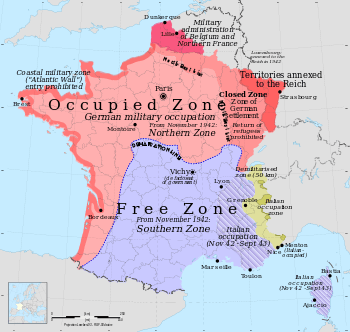Zone interdite

The zone interdite ("forbidden zone") refers to two distinct territories established in German occupied France during the Second World War after the signature of the Second Armistice at Compiègne.
Coastal military zone
A zone of restricted access to civilians was established to increase the security of the Atlantic wall. It was 20 km wide and ran along the Atlantic coast from Dunkirk to Hendaye.[1] It was administered by the military administration in Northern France and Belgium (German: Militärverwaltung in Belgien und Nordfrankreich) from Brussels.[2]
Zone of intended German settlement
A vast expanse of territory in northern and eastern parts of occupied France comprising a total of six départements and parts of four others running from the mouth of the Somme to the Swiss frontier in the Jura.[1] This area was separated from the rest of the Occupied Zone by a demarcation line and was effectively cut off from the rest of France.[1] The terms zone réservée ("reserved zone") and zone interdite were often used interchangeably, but some sources distinguish a smaller forbidden zone, comprising parts of Somme, Aisne and Ardennes départements, from the larger reserved zone.[1] This extra demarcation line never seems to have existed beyond theory.[1]
Although Adolf Hitler had initially no plans of territorially expanding towards eastern France except for the return of the formerly German Alsace-Lorraine (even so he did not regard the acquiring of these provinces as a real benefit to Germany, telling Albert Speer his belief that they had become "racially worthless" after decades of French rule[3]), the position of total German hegemony gained after the Battle of France now made it possible for him to plan the annexation of those regions of France deemed of possessing strategic or economic advantage to Germany.[4] This was especially the case with frontier regions whose incorporation could be somehow justified on the basis of historical Franco-German borders.[4] During the end of May 1940 (before the Armistice), Hitler instructed Wilhelm Stuckart, State Secretary in the Ministry of Interior to prepare suggestions for a new western frontier.[4] A memorandum written on June 14, 1940 by Stuckart or someone in his vicinity in the Interior Ministry discusses the annexation of certain areas in Eastern France to the German Reich.[5] The document presents a plan to weaken France by reducing the country to its late mediaeval borders with the Holy Roman Empire and replacing the French populace of the annexed territories with German settlers.[5] This memorandum formed the basis for the so-called "North-east line" (also called the "Black line" and the "Führer line"),[6] which marked the territorial extent of the forbidden zone.
On 28 June 1940 the zone was hermetically closed, allegedly because of devastation caused by heavy fighting during the German campaign.[4] The refugees who had fled the German advance during the Battle of France were not initially allowed to return to the territory, but passes were however gradually increased for workers in short-staffed occupations.[4] After August 1940, the lands of farmers who had not returned to the zone were confiscated by the Ostdeutsche Landbewirtschaftungsgesellschaft ("East German Land Management Company") which managed confiscated Polish farmlands.[4] The company took the name Westland in the forbidden zone, and by the summer of 1942 was managing some 4 million hectares of farmland.[4] Land redistribution to German peasants was however not possible because of the limited quantity of potential settlers.[4]
The German forces guarding the line were insufficient in number to prevent the return of the territory's inhabitants, and thus by the end of 1940 only about a million of them were still missing (amounting roughly to one-seventh of the pre-war population).[4] During the night of 17–18 December 1941 the German troops guarding the line were simply withdrawn, as the military commander of France Otto von Stülpnagel deemed the line being merely illusionary since virtually the whole population had returned.[4] In theory the line continued to exist for the rest of the German occupation.[4]
References
- 1 2 3 4 5 Jackson, Julian (2003). France: the dark years, 1940-1944. Oxford University Press. pp. 246–247. ISBN 0-19-925457-5.
- ↑ Vinen, Richard (2006). The Unfree French: Life under the Occupation (1st ed.). London: Allen Lane. pp. 105–6. ISBN 0-713-99496-7.
- ↑ Overy, Richard (2002). The Nazi Elite in Allied Hands, 1945, p. 325. Penguin Books.
- 1 2 3 4 5 6 7 8 9 10 11 Kroener, Bernhard R.; Müller, Rolf-Dieter; Umbreit, Hans (2000). Germany and the Second World War:Organization and mobilization of the German sphere of power. Wartime administration, economy, and manpower resources 1939-1941. Oxford University Press. pp. 160–162. ISBN 0-19-822887-2.
- 1 2 Schöttler, Peter (2003). "'Eine Art "Generalplan West": Die Stuckart-Denkschrift vom 14. Juni 1940 und die Planungen für eine neue deutsch-französische Grenze im Zweiten Weltkrieg.". Sozial.Geschichte (in German). 18 (3): 83–131.
- ↑ Jäckel, E. (1966). Frankreich in Hitlers Europa, Deutsche Vlg. p. 89